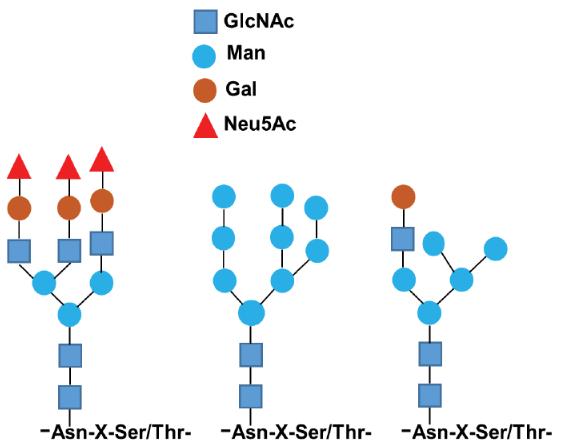Fc fusion protein (Fc-Fusion) has a complex and diverse molecular structure, and may contain glycosylation modification sites at amino acid 297 of its Fc fragment and the Fab region of some molecules. Moreover, its biological ligands are structurally diverse, and their glycosylation modifications may also be complex, usually involving multiple N-glycan and O-glycan sites and a large number of sialic acids.
Glycosylation has a significant impact on the pharmacokinetics (PK), pharmacodynamics (PD), immunogenicity and clinical efficacy of Fc-Fusion, and is a key quality indicator for Fc-Fusion-related biologics, so regulatory agencies require manufacturers to determine the carbohydrate content of glycoproteins (neutral sugars, amino sugars and sialic acid) and the glycosylation sites on oligosaccharides and peptide chains. Therefore, for the development of Fc-Fusion-related drugs, it is necessary to gain insight into the impact of glycosylation on product quality through various characterization techniques and to closely control the glycosylation of the target product to ensure proper safety and efficacy.
Fc-Fusion Glycosylation and Its Biological Significance
Glycosylation
Therapeutic monoclonal antibodies (mAb) or mAb variant molecules such as Fc-Fusion have an N-linked glycan coherent sequence of (Asn)-X-Ser/Thr (where X is any amino acid except Pro) at the Asn297 position of the heavy chain of the constant CH2 domain, and some mAb also have additional glycosylation modifications in the Fab domain. In addition, some of the diverse biological ligands of Fc-Fusion also have different types and levels of O-linked glycans.

The structures of N-linked glycosylation proteins
Biological Significance of Glycosylation
Changes in the glycan composition and structure of Fc-Fusion can cause conformational changes in the structural domain of Fc, which can alter its binding affinity to the Fcγ receptor and consequently lead to functional changes in immune effectors. Fc-mediated antibody effector functions include complement-dependent cytotoxicity (CDC), antibody-dependent cell-mediated cytotoxicity (ADCC), and anti-dependent cell-mediated phagocytosis ( ADCP), all three effector functions are triggered by the formation of immune complexes, which subsequently recruit complement proteins and/or effector cells. Fc receptors (FcγR) are composed of an activation receptor family and an inhibitory receptor (FcγRIIb). Among them, the activation receptors in mice are generally FcγRI, FcγRIII and FcγRIV, and in humans are FcγRIa, FcγRIIa and FcγRIIIa receptors. The absence of glycosylation modifications significantly weakens the binding affinity of Fc to FcγRI and prevents it from binding to FcγRII and FcγRIII receptors.
Changes in certain glycoforms in therapeutic Fc-Fusion can also affect the pharmacokinetics (PK) and pharmacodynamics (PD) of the molecule. Glycans with significant effects on their PK and PD include mannose (Man) , sialic acid (Sia), fucose (Fuc) and galactose (Gal): mannosylated glycans affect the PK of the molecule, thus reducing the exposure time of the drug in the body and therefore may lead to reduced efficacy; the levels of sialic acid and N-acetylneuraminic acid (NANA) also significantly affect the PK of Fc-Fusion; Fc-Fusion with high core fucose content in the glycan structure binds weakly to the Fc receptor FcγIIIa and therefore has lower ADCC activity compared to Fc-Fusion lacking fucose; terminal galactose has an important role in CDC activity, and lower levels of galactose lead to lower CDC activity of Fc-Fusion. Glycans also affect the safety of Fc-Fusion. For example: Fc-Fusion produced in mouse myeloma cells such as NS0 and SP2/0 contains glycans such as Gal1–3Gal1–4N-acetylglucosamine-R and N-glycineneuraminic acid (NGNA), which are Naturally occurring glycans in humans may lead to adverse immunogenic responses.
Therefore, it is necessary to develop efficient characterization techniques to gain a deeper understanding of the impact of glycosylation on PK and PD and to ensure its strict control during the manufacturing process, which is necessary for the development of Fc-Fusion drugs.
Reference
- Wang S, He Q, Ye J, Kang Z, Zheng Q, et al. (2020) N-linked Glycosylation and its Potential Application in Drug Development. Health Sci J. 14 No. 5: 743.
Related Service
Fusion Proteins Characterization
Monoclonal Antibody Characterization
Antibody Drug Characterization
Antibody Drug Conjugates (ADCs) Characterization
Bispecific Antibody Characterization
Related Resource
Introduction and Characterization of Monoclonal Antibody Drugs
Application of Mass Spectrometry Technology in Antibody Drug Analysis
Characterization of Monoclonal Antibodies in Biopharmaceuticals






